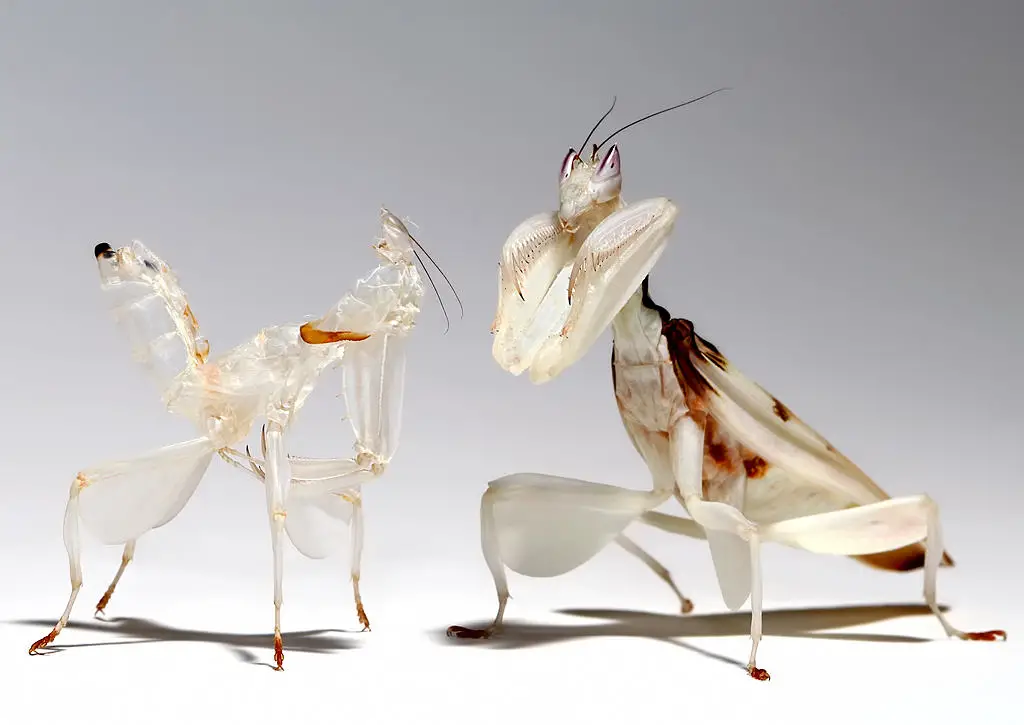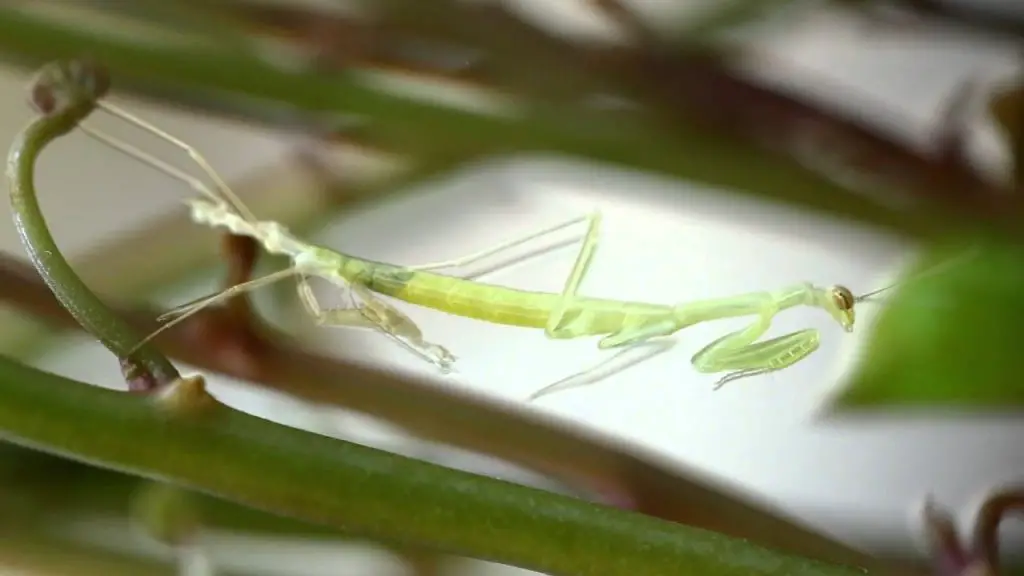In the captivating world of praying mantises, there exists a mesmerizing process known as molting—a key to their growth and development. As these intriguing creatures shed their exoskeletons, they embark on a journey of transformation that fascinates nature enthusiasts and insect aficionados alike. From the stages of molting to the frequency with which they molt, questions like “How often do praying mantises molt?” and “What are praying mantis molting stages?” beckon us to explore the secrets behind this remarkable phenomenon. Join us as we embark on an exploration of the delicate art of praying mantis molting, uncovering the signs, mechanics, and significance of this natural spectacle that underscores the resilience and vulnerability of these extraordinary insects.

Do praying mantis shed their skin?
Yes, praying mantises do shed their skin, a process known as molting. As these fascinating insects grow, their exoskeleton becomes rigid and restricts further development. To accommodate their increasing size, praying mantises undergo a unique molting process. During molting, they carefully extricate themselves from their old exoskeleton, leaving behind an empty shell that resembles their previous form. This vulnerability lasts only temporarily, as the mantis soon reveals a new, softer exoskeleton underneath, which will eventually harden to provide protection and support for their continued growth. The molting process is a critical aspect of their life cycle, enabling them to thrive and adapt to their surroundings while captivating observers with the marvels of nature’s wonders.
Understanding the Stages of Praying Mantis Molting
The molting process of praying mantises is a fascinating spectacle, unfolding in several distinct stages. Initially, as a mantis approaches its molting phase, it exhibits subtle behavioral changes, such as reduced activity and decreased appetite. As the moment approaches, the insect seeks a secure location, where it can safely undergo the transformation. During the actual molting event, the praying mantis carefully wriggles out of its old exoskeleton, leaving it behind as an empty shell. This delicate shedding reveals the mantis in a new, soft, and vulnerable form, which gradually hardens over time to provide renewed protection and support.
Exploring the Reasons Behind the Molting Process
The molting process of praying mantises serves a vital purpose in their life cycle. As these remarkable insects grow, their exoskeleton becomes rigid, hindering further expansion. Molting is a necessary adaptation that enables mantises to shed their old, confining exoskeleton and reveal a larger, more flexible one underneath. This renewal allows them to accommodate their increasing size, providing the freedom to continue their development and adapt to changes in their environment. With each successful molt, praying mantises gain the ability to hunt more effectively, seek larger prey, and develop into formidable predators. After the final molt some species are even able to fly!
Praying mantis molting signs
Praying mantis molting exhibits a fascinating array of signs that indicate an approaching molt. As the pre-molt phase sets in, these intriguing insects display several characteristic behaviors:
- Refusal of Food: In the pre-molt phase, praying mantises exhibit a reduced appetite and may refrain from eating for several days, signaling an impending molt.
- Lethargy and Vibration-like Movements: The mantis becomes less active and displays erratic vibration-like movements, indicating that it is preparing for the molting process.
- Inflation of the Abdomen: One of the most telltale signs, the inflation of the abdomen becomes evident, especially if the mantis has been rejecting food. This inflation allows them to absorb air before the molt.
- Hanging from the Enclosure: Praying mantises in pre-molt may hang from the top of their enclosure, a behavior typical of this phase, but watch for other accompanying signs.
- Slightly Parted Raptorial Arms: Observe the mantis’s front arms; if they are slightly parted, it may indicate that the molting process is near.
- Elongated and Extended Body & Legs: As the molt approaches, the mantis stretches down from the enclosure’s top, showcasing an elongated body and extended legs.
Remember, it is crucial not to disturb the mantis during the molting process. After praying mantis shedding its old skin, the insect enters the hardening phase, during which it hangs suspended in the air, attached only by its lower abdomen. This phase is vital for fortifying the new exoskeleton into a strong defensive exterior, resembling its previous skin. During the molting and hardening phases, the mantis undergoes growth as the new exoskeleton remains pliable enough to accommodate its development. By observing these signs and providing a calm environment, you can ensure the successful and awe-inspiring molting process of these remarkable creatures.
How often does a praying mantis molt?
The frequency of praying mantis molting varies throughout their life cycle and is influenced by factors such as species, environmental conditions, and individual growth rates. Generally, praying mantises undergo a series of molts as they progress from nymphs to adulthood. During their early stages, nymphs molt more frequently, sometimes as often as every few days, as they experience rapid growth and development. As they mature, the molting frequency typically decreases, occurring at longer intervals, such as every few weeks or months.
After reaching it’s final molt praying mantis can live up to few months without molting before dying. The number of molts a praying mantis experiences throughout its life can vary from five to ten or more, depending on the species and environmental conditions.

How to care for praying mantis during molting?
Caring for a praying mantis during the molting process requires a delicate and attentive approach to ensure the successful transformation of these captivating insects. Here are some essential tips to provide the best care during this vulnerable phase:
- Observe Pre-Molt Signs: Pay close attention to signs of an impending molt, such as reduced appetite, lethargy, and inflation of the abdomen. Recognizing these cues allows you to prepare for the upcoming molting event.
- Create a Calm Environment: Minimize disturbances in the mantis’ enclosure and provide a secluded space. Avoid handling or unnecessary movement near the mantis during the pre-molt phase and throughout the molting process.
- Ensure Proper Humidity: Maintaining adequate humidity levels in the enclosure is essential for a successful molt. Dry conditions can make molting difficult, so use a misting system or a water source to maintain appropriate humidity levels.
- Offer Safe Surfaces: Provide suitable surfaces for the mantis to anchor itself during the molting phase. Branches, twigs, or other textured materials allow the mantis to hang and shed its old exoskeleton comfortably.
- Avoid Disturbing the Molting Mantis: Once the mantis begins the actual molting process, refrain from handling or interfering with the insect. Disruptions can lead to complications and potentially endanger the mantis.
- Observe Hardening Phase: After the molt, the mantis will hang suspended in the air during the hardening phase. Resist the urge to move the mantis during this time as the new exoskeleton firms up and strengthens.
- Provide Adequate Food: Once the mantis has fully hardened and regained mobility, offer appropriate-sized live prey as it regains its strength.
- Monitor and Record: Keep track of your mantis’ molting frequency and note any irregularities or difficulties during the process. This information can be valuable for future care.
By following these tips and maintaining a watchful eye during the molting phase, you can offer the best possible care and support for your praying mantis, contributing to its successful development and overall well-being.
Why Does My Praying Mantis Have Molting Problems?
Praying mantises, fascinating as they are, can encounter various molting problems that pose significant risks to their health and survival. Mismolts, incomplete or problematic molting, can manifest in twisted legs or when the outer layer of the exoskeleton isn’t entirely shed, potentially leading to fatal consequences. To address and prevent such issues, providing proper hydration is crucial. Regular misting of the mantis’ enclosure ensures good hydration, while feeding it hydrated insects also aids in maintaining its water balance.
Additionally, a fabric top enclosure allows the mantis to hang upside down comfortably during the molt, preventing mishaps. Limiting decorations in the enclosure and sterilizing any added items minimize the risk of infections. In case of an infection, amputation of the affected leg just above the infection point can be a life-saving measure. By implementing these preventive measures and ensuring the well-being of the praying mantis, enthusiasts can offer the best possible care and support during the critical molting process.

Summary
In the mesmerizing world of praying mantises, molting unfolds as a captivating transformation essential for their growth and development. This article delves into the various stages and significance of the molting process, shedding light on the signs that indicate an approaching molt. Discover how to care for praying mantises during this vulnerable phase, providing a conducive environment and ensuring proper hydration. Learn about mismolts and incomplete molting, along with expert solutions and preventive measures to handle molting problems. Whether you are a mantis enthusiast or a caregiver, this comprehensive guide offers invaluable insights and techniques to support a successful and thriving praying mantis molting experience.
If you found this article interesting, don’t hesitate to share it on social media!
May interest you
Can praying mantis eat fruit?
Truth or myth: Do Praying Mantis Spit?
The Surprising Benefits of Praying Mantis in Garden
Do Praying Mantis Eat Ladybugs, Bees, and Other Beneficial Insects?
Do praying mantis drink water?
Mystical World of the insects: Praying Mantis Spiritual Meaning
In this article, we embark on a journey to delve into praying mantis spiritual meaning, uncovering its symbolic significance and exploring its presence in art, mythology, and spiritual practices. The…